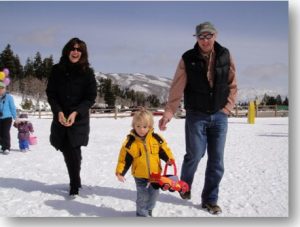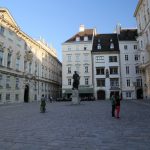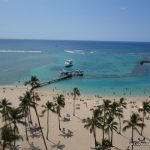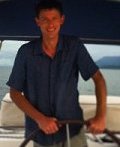 In the evolution of a place there is sometimes a waymark between free-spirited childhood and the discreet somberness of maturity. But what if the in-between actually signifies the third point of a classic Hegelian dialectical triangle? A rough and rowdy cowboy town at one point, an overly-wrought sophisticated metropolis at the other, and the third being some subtly unstated “third way” that draws on the contradictory nature of the first two states to create a superior third? Jackson Hole may be that mythical intersection, deftly incorporating elements of the small town with the big city, a realization of humanity’s most advanced thought: the idea that recognizes its good self in all things.
In the evolution of a place there is sometimes a waymark between free-spirited childhood and the discreet somberness of maturity. But what if the in-between actually signifies the third point of a classic Hegelian dialectical triangle? A rough and rowdy cowboy town at one point, an overly-wrought sophisticated metropolis at the other, and the third being some subtly unstated “third way” that draws on the contradictory nature of the first two states to create a superior third? Jackson Hole may be that mythical intersection, deftly incorporating elements of the small town with the big city, a realization of humanity’s most advanced thought: the idea that recognizes its good self in all things.
The first ski lift in Jackson Hole opened in 1964, with two double chairlifts. Prior to that, winter was known as “Cocktail Hour in Jackson Hole,” as the only thing to do was drink.
When I first arrived in 1980 it was like an exotic movie set, hard to get to, as picturesque as a jigsaw puzzle. I was enlisted to be Robert Duvall’s stunt double for the film Pursuit of D.B. Cooper. The conceit: D.B. Cooper (played by Treat Williams) has parachuted into the mountains with his loot, and escapes down a wild river on a raft, with Duvall’s character in hot pursuit, plunging down huge rapids and over sheer waterfalls. I picked up my share of bruises and scratches, but the only one that remained was the itch to return to Jackson Hole.
And I did…over and over. Once to take Glenn Campbell, Tanya Tucker and Barbi Benton rafting for an ABC show. A couple of times to hike and fish (there are more miles of Wild & Scenic waters here than any other county in the country). And most recently for a wedding. But always in summer.
Now, at last, I make a winter ramble to Jackson Hole, and fall into a magic casket of promises, an invisible vibrating wall between the feather-bed of civilization and the hyperterra of a tectonic seam.
I take a non-stop from Los Angeles (there are now 12 non-stops, from as far away as New York), and make the short drive into the nave of the valley, between a title wave of stone, through town and then up to Spring Creek Ranch, which offers up accommodations with windows the size of Wales, overlooking the white flames of the Tetons and vistas that showcase seemingly boundless wilderness. Only 3% of the land is privately owned here.
So, what is this place?
In 2011 John Kasarda published a book, Aerotropolis: The Way We’ll Live Next, describing a new urban form placing airports in the center with cities growing around them. I’ve been to many of these airport cities, and found them soulless, clone-like, thick with franchises and the commerce of expediency. Jackson Hole has an airport, the only one in America in a National Park, but there is nothing Xeroxed about it. The largest elk migration in the world is just outside the door. Try to find that anywhere else.
After traveling to metropolises and micropolises (populations between 10,000 and 50,000) around the world, this place seems different, something evolved to a higher plane, but what?
I scratch about and come up with what I think a suitable descriptor: a montropolis….a mountain town that offers up not just the riot of the natural world, and the cosmopolitan rewards of a first-class city, but then goes beyond. The components: 1) a rich art culture 2) luxury and elegance, but of a rustic flavor 3) an abundance of wildlife 4) family friendliness 5) A strong conservation ethos and 6) a range of snow and ice adventures. These six ingredients, mixed generously together, concoct Jackson Hole, perhaps the first montropolis.
After settling in, I decide to test my notion, and head to town to check out the art scene. Jackson Hole has a bewilderingly disproportionate number of artists and galleries: over 50 art galleries in a township of less than 10,000, and you can practically throw a snowball in any direction and hit an artist. I begin with a stop at the Trio Gallery on North Cache Street, where I meet up with Kathryn Turner, a pedigree painter born and raised on a dude ranch in Grand Teton National Park. We sit in front of two towering, silvery canvases of aspens, so uncluttered they speak of Kathryn’s “beautiful destructionism,” wherein the results are so striking because she purposely leaves things out.
She says the hyper-dramatic landscapes of Jackson Hole inspire art….it’s everywhere one looks, ever changing, and the natural desire is to try to capture, or render, or express. “Jackson Hole is a place of intensity. The mountains are intense; the climate is intense…and that intensity pushes art.
“What is sublime about the landscape is that it gives us a sense of wonder. It’s bigger than we are, which transcends into the spiritual. The mountains are imprinted in my soul. Painting is my map of discovery. I will commit my entire life to trying to capture the essence of the Tetons…and it will take a lifetime.”
To demonstrate Kathryn offers an alla prima, a “quick draw,” on the spot. She adjusts her easel, dips a brush into her soul, and beings her silent poetry. Minutes later, like morning fog lifting over the Snake River, there appears the lovely portrait of a horse from her ranch.
Next I head north a couple miles to the National Museum of Wildlife Art, which sprawls like a Scottish castle on a bluff overlooking the “Museum on the Hoof,” the National Elk Refuge. Inside I meet President Jim McNutt, polite as a wine steward, who offers a little turn through the 51,000-square-foot shrine.
We stroll by an illustration of a bison herd thundering across the prairie, a sculpture of a grizzly reclining, and Andy Warhol’s 1983 vivid screen prints of endangered species from around the globe, just some of the more than 5,000 cataloged drawings, paintings, sculptures and sketches in the nation’s premier public collection of artwork devoted to wild animals. We pass an ark of styles, Romanticism, Realism, Impressionism, Modernism, and my favorite, explorer art. We admire oil, bronze, stone, acrylic, watercolor, gouache, pastel, pencil, lithography, photography, charcoal, and real flesh.
Outside stands a life-size sculpture of elk crossing a rock. This is where the real and the unreal blur, as just beyond thousands of live elk are drifting by in their natural winter setting.
Every moment is a monument at my next stop, the hub of creativity known as the Center for the Arts, an expansive pavilion that hosts a 500-seat theater, art and dance studios, and classrooms. My friend Lisa Sanford (we produced a film on orangutans in Sumatra many years ago) is the Executive Director of the Jackson Hole Wildlife Film Festival, and her offices are here. But I knock on her door, and she’s not around. I’m not surprised. It’s gorgeous outside, full of stolen light, and not many folks in Jackson stay within on a super ski day.
Instead, I meet Ponteir Sackrey, the Center Fund President, who gives a brief tour, and explains something called The Creative Vitality Index, which measures the health of the creative economy in a community. Not surprisingly, Jackson is near the top of the list.
That evening the sky glows like a bottle of cognac held up to the light. I decide to explore some of the rustic-style elegance that is requisite in the model of montropolis. When I first came to Jackson I crashed on a guide’s log cabin couch, which was about as luxurious as you might get. But today there is a plethora of luxury hotels, from the Four Seasons Resort in Teton Village to the Wort Hotel downtown to the Amangani, The Rusty Parrot, the Hotel Terra, and of course the soigné Spring Creek Ranch, where I’m staying. I have a cocktail with Steve Price, the general manager, at the Granary, the bar where the peaks outside the glass are skywriting. “These are the first mountains that look like mountains should,” Teddy Roosevelt supposedly said when first gazing at the sonic architecture. Before him it was a set of 18th century French-Canadian fur trappers, long on the road and womanless, who named the soaring mountains after female breasts: Tetons.
“I don’t think anyone in America didn’t want to grow up to be a cowboy or cowgirl, “Steve posits with a smile wide as a hammock. “And here you can become that dream, while still steeped in the finer things in life.
“Rustic elegance here means you can kick up your boots like a cowboy, revel in the romance of the American West, wrap in the authenticity, but still enjoy the finest wines, food and comfort to be found anywhere.”
Afterwards, I take a stroll through the town square to check out the shopping. High-end offerings such as Rodeo, 22 Home, Belle Cose, Wool and Whiskey, and CocoLove, a world-class chocolatier, now inhabit this town, and give it a Beverly Hills-with-altitude feeling. Oh look…Harrison Ford just came out of that shop.
For dinner I meet up with Gavin Fine at Il Villagio Osteri, a seriously good Italian restaurant, and part of his Fine Dining Restaurant Group, which includes Rendezvous Bistro, Q Roadhouse, The Kitchen, and Bin 22. Gavin’s story is not dissimilar to so many who live here. He came out years ago from restaurant-rich Chicago for a weekend of skiing and never went back. He’d been working at for Lettuce Entertain You in Chicago, and just found everything about Jackson more fulfilling, authentic and to his taste. “I chose Jackson Hole to stay and live because of the soul and the character. It’s not a stop off the highway. It’s a vast valley that sucks you in. And you never leave.” It sounds like Hotel California, though they actually do have that spirit from 1969.
We compare notes over wood-oven fired Guido Sarducci pizza and housemade orecchiette, and he says his philosophy is “you’re only as good as your last meal.” I counter, “Those who forget the pasta are condemned to reheat it.”
The following day, under columbine skies, I head out to see the wildlife up close and personal. Some beasts are unavoidable…I keep running into traffic jams on the road as folks slow down to gawk at moose chewing branches a few feet from the pavement. But the grand display is the American Serengeti, the 25,000-acre National Elk Refuge, where up to 10,000 wintering elk make their grounds.
The refuge was established in 1912 to ensure the survival of the herd after a combination of human development and severe winters took their toll. It now provides a non-enclosed sanctuary for the largest elk herd on Earth. I make my way to an entrance on the western side, just past a section of Flat Creek stirring with trumpeter swans. I jump on a horse-drawn sleigh, driven by guide Jeff Warburton, who entertains and informs as we jangle about the refuge wrapped in thick blankets, watching the elk aimlessly munch on staff-provided alfalfa pellets. Where else can you get this close to a 1000 lb. feral animal with a rack the size of a chandelier? The theory is that by encouraging children and parents to get close enough to look into the eyes of a wild elk, it is harder to take actions that might hurt them. In many cases, says Jeff, people fall in love, and people conserve what they love.
The sleigh ride is ideal for kids, including my six-year-old, Jasper, whose eyes are so wide he seems to be devouring the future. But it’s not the only family friendly thing to do in Jackson Hole….in fact, the county has transformed into an outdoor concourse for kids, another of the montropolian merits. Not long ago the valley, which even at its lowest point is over a mile high, was a cult destination for extreme skiing; not much of a family stop. But now the frozen assets include everything from bunny run skiing to tubing to snowshoeing, snowboarding, dogsledding, horseback riding, cross-country, snowmobiling, snowbiking, ice climbing, sledding, ice skating…there’s even a children’s museum. If ever you worry about the kids spending too much time in front of screens, this is the antidote to Angry Birds. Unplug, boot it down, let the screen be in the frame of the Tetons, and the glow come from the winter sun, and the challenges and glee come from Nature. Jackson Hole removes every excuse for staying in.
Another quality of the montropolis is a strong conservation ethos, and Jackson Hole is the birthplace of the modern conservation movement. Here they conserve soil, they conserve water, they conserve wildlife, they conserve open space, they conserve scenery.
It could be argued that the original Native Americans here embraced a conservation ethic as they revered these peaks that stretched their sky. There was a great spiritual connection. And the environment was so harsh and resources so limited it took a preservation stance to survive.
But the movement first found traction in 1897 when a Colonel S.B.M. Young, acting Superintendent of Yellowstone, proposed to expand Yellowstone’s boundaries southward to encompass portions of northern Jackson Hole and protect migrating elk herds.
John D. Rockefeller, Jr. stood beneath the gleaming silver blades of the Tetons in 1924 and was mightily impressed. The Yellowstone Superintendent at the time seized the opportunity to explain the hope of protecting and preserving “this sublime valley” from unsightly commercial development. Rockefeller decided to purchase offending private properties with the intention of donating them to the National Park. It took more time than anticipated. The creation of Grand Teton National Park finally occurred on September 14, 1950, when Harry S. Truman signed the bill. Now, 97% of the land in Teton County is protected.
One synecdoche for the whole of the valley is the Teton Raptor Center. It started in 1997 when Roger Smith, a philosoraptor and wildlife biologist, started receiving calls to take in injured raptors. As he took in more birds, he expanded to rescue and rehabilitation, and then education and conservation. The center is now based in a set of old red barns at the base of Teton Pass in Wilson, and seems about to burst its seams with birds of prey.
Roger shows off eagles, kestrels, hawks and gyrfalcons, and then brings out Owly, a female great-horned owl, whom Roger rescued after she was hit by a car. She does her Linda Blair head swivel, locks her big eyes onto mine, and we exchange meaningful looks. We connect.
Roger thankfully breaks the moment “The real take-home message is that by knowing these birds we start understanding how things are connected. It’s easy to start putting the environment second fiddle if you don’t understand how things work.”
Afterwards I head over to the Mead Ranch where I meet up with Kate and her husband Brad Mead, whose great grandfather homesteaded here more than a century ago. In 2002, the family placed the ranch under conservation easement, ensuring that its pristine water, native pastures, open space and language-defying scenery would be protected forever. And now they raise the happiest cows in the world.
“For us, as a family, it’s really important that our cattle are treated right. They live a fantastic life out here. They hang out, look at the mountains, and don’t have to worry about much of anything. No feedlots; they roam free. We don’t give them growth hormones, steroids or antibiotics. We don’t feed them corn, just grass and recycled spent grains from the local brew pub. We treat them in a humane and respectful way. And they live quite a bit longer.”
I’ve worked up an appetite listening to Kate, so head over to the Q Roadhouse, and meet Matty Melehes, the chef, who sizzles with local goodness here. “We have a local band, local artists on the wall, a burger from the Mead Ranch, on a bun from a local bakery, using mustard made from a local beer, cheese from a local farm, and I’m from Jackson Hole, so I’m local as well.” Of course, I order a vegetable salad, but vegetables lack a sense of purpose when unaccompanied by a good cut of meat, so I call for the ranch burger as well, and it is, no denying, localicious.
The next couple days are devoted to the final quality needed to be proclaimed a montropolis: great snow motion. My visit happens to coincide with WinterFest, which is bookended on two weekends by Cutter Races and Ski-Joring. The former is a contest in which chariot-like vehicles are pulled by two horses a quarter mile down a snow-packed track. It’s also one of the biggest tailgate parties of the year, but all for a good cause. It’s sponsored by the Shriners, and the motto is, “The Cutters run so a child may walk.”
The other event, Ski-Joring, is a wild winter diversion in which a person on skis is pulled by a long rope attached to a racing horse through gates and over six-foot-high jumps down a 500-yard track. Not for the faint of heart, either to participate, or even watch. It’s no coincidence that the poster advertisers at the end of the run are “Teton Orthopedics” and “St. John’s Family Health and Urgent Care.”
But I’m here in Jackson Hole to partake, and begin with a cross-country ski run. I hook up with Jack Bellorado, who runs the Teton Pines Cross Country Ski Center, and together we head out to kick and glide some 10 miles of machine-groomed tracks beneath the fountains of the earth that are the Tetons.
At one point we pass Olympic athlete Erich Wilbrecht, competitor in the 1992 Winter Games on the Biathlon team. He’s out for a little spin, at 60 miles an hour. “Once you’ve skied here, where else you gonna go?”
In the afternoon I catch up with Jess McMillen, the Freeskiing World Tour Champion, and the U.S. Freeskiing National Champion, and a keen champion for Jackson Hole, which she says is the best training grounds for freesking there is. She was born and raised here, but at 18 took off to check out the great cities and alpine villages of the world. Didn’t take long to return to the Golden Mean and plant roots. “I realized Jackson Hole has everything I’m looking for.”
We take the aerial tram up the Jackson Hole Mountain Resort, which boasts the longest continuous vertical rise of any ski resort in the country. “Every morning I wake up and look at the Grand Tetons and feel like I’m one of the luckiest people alive.”
It used to be that the skiing was famously black, on big terrain, but now they’ve re-designed so there are blue runs to the base at every major lift, making this a family friendly experience. Still, once at the top, Jess says “Let’s go ski some cowboy powder,” and rockets away, blond hair flying, and I’m left to enjoy the view and the blue. Can’t blame her. There are no friends on a perfect powder day.
For my final outing I team up with Mike Halpin, owner of Lost Creek Ranch Lodge & Spa, where the Modern Family cast stayed for one of their vacation episodes. Mike is a sled head, a snow machine buff, and claims that Jackson Hole has the best snowmobiling in the world. He offers to take me on one of his favorite runs, a ten-mile spin to Granite Hot Springs (we are, after all, adjacent to the most geo-thermally active terrain in the world.)
It’s snowing hard when we start out (in the winter Jackson Hole gets 42 days of snow…every month), but soon clears to ice blue skies as we whiz past dogsledders and scenery that chews it is so dramatic. After a couple hours riding through this supernal painting, our noses fill with the sharp perfume of sulfur. We park, and slip into a little rip in the earth’s crust that is the 104-degree hot springs, and soak away whatever residual blues came from beyond the blazing poetry of this place. At this moment it seems life beyond this valley is error. This is the place to be. This is montropolis.







Leave a Reply